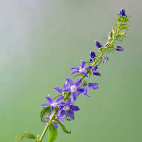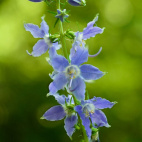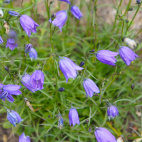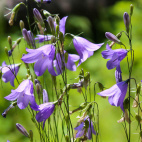Tussock Bellflower Seeds
- HOW TO GROW
- FAST FACTS
- REVIEWS
HOW TO GROW
Sowing: Direct sow in late fall, planting tussock bellflower seeds on the surface of the soil and compacting it lightly. Do not cover the Campanula Carpatica seeds, since they need light to germinate; they are best kept moist until germination, which should occur within several weeks. For spring planting, mix the seed with moist sand and store it in the refrigerator for 30 days before direct sowing. To start the plants indoors, sow the seed on the surface of the soil of a flat; keep the temperature at 65-70 degrees F and the soil lightly moist until germination. As soon as the seedlings develop leaves, thin or transplant them.
Growing: This plant adapts well to rocky or poor soil, and grows best in well drained soil. It should be watered regularly, but too much moisture may cause disease; for best results, water deeply and let the soil dry out before the next watering. For the best blooming, remove faded blossoms to allow for new ones; after the plant has finished blooming, the foliage can be trimmed back by one third to tidy its growth and prevent reseeding. After several years of growth, these plants can be divided. This plant attracts butterflies and bees, and makes a lovely addition to rock gardens.
Harvesting: For fresh flowers, cut the stems just when they have begun to bloom. Place them in water immediately.
Seed Saving: Since the tiny seed pods on the stalk will ripen at different times, the seed will need to be harvested over period of time. Shake the entire plant over a container to remove the seed that has ripened, repeating the process every few days until all the seed on the stalk has ripened. Store the cleaned tussock bellflower seeds in a cool, dry place.
FAST FACTS
Common Names: Carpatic Bluebell
Latin Name: Campanula carpatica
Species Origin: Central and Eastern Europe
Type: Garden Flowers
Life Cycle: Perennial
USDA Zones: 2, 3, 4, 5, 6, 7
US Regions: Mountain, Plains/Texas, Midwest, Northern, Northeast
Seeds per Ounce: 350,000
Stratification: Cold/Wet for 4 Weeks
Germination Ease: Stratify 4 Weeks
Sunlight: Full Sun, Part Sun, Shade
Height: 12 Inches
Color: Pink, Blue
Bloom Season: Blooms Early Summer, Blooms Late Summer
Uses: Cut Flowers
A delightful bloom
These blooms are a delight. I love them.
DESCRIPTION

HOW TO GROW
Sowing: Direct sow in late fall, planting tussock bellflower seeds on the surface of the soil and compacting it lightly. Do not cover the Campanula Carpatica seeds, since they need light to germinate; they are best kept moist until germination, which should occur within several weeks. For spring planting, mix the seed with moist sand and store it in the refrigerator for 30 days before direct sowing. To start the plants indoors, sow the seed on the surface of the soil of a flat; keep the temperature at 65-70 degrees F and the soil lightly moist until germination. As soon as the seedlings develop leaves, thin or transplant them.
Growing: This plant adapts well to rocky or poor soil, and grows best in well drained soil. It should be watered regularly, but too much moisture may cause disease; for best results, water deeply and let the soil dry out before the next watering. For the best blooming, remove faded blossoms to allow for new ones; after the plant has finished blooming, the foliage can be trimmed back by one third to tidy its growth and prevent reseeding. After several years of growth, these plants can be divided. This plant attracts butterflies and bees, and makes a lovely addition to rock gardens.
Harvesting: For fresh flowers, cut the stems just when they have begun to bloom. Place them in water immediately.
Seed Saving: Since the tiny seed pods on the stalk will ripen at different times, the seed will need to be harvested over period of time. Shake the entire plant over a container to remove the seed that has ripened, repeating the process every few days until all the seed on the stalk has ripened. Store the cleaned tussock bellflower seeds in a cool, dry place.
FAST FACTS
Common Names: Carpatic Bluebell
Latin Name: Campanula carpatica
Species Origin: Central and Eastern Europe
Type: Garden Flowers
Life Cycle: Perennial
USDA Zones: 2, 3, 4, 5, 6, 7
US Regions: Mountain, Plains/Texas, Midwest, Northern, Northeast
Seeds per Ounce: 350,000
Stratification: Cold/Wet for 4 Weeks
Germination Ease: Stratify 4 Weeks
Sunlight: Full Sun, Part Sun, Shade
Height: 12 Inches
Color: Pink, Blue
Bloom Season: Blooms Early Summer, Blooms Late Summer
Uses: Cut Flowers
Reviews
Review
A delightful bloom
These blooms are a delight. I love them.
Also Consider These:
-
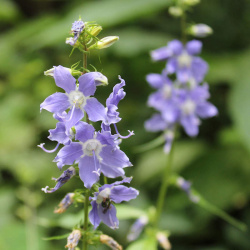 Tall Bellflower Seeds
Campanula americana
Quick View
x
Tall Bellflower Seeds
Campanula americana
Quick View
xTall Bellflower Seeds
Starting at $3.75 USD -
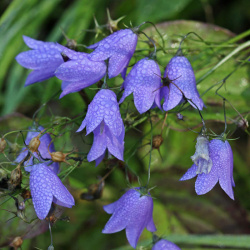 Out of Stock
Harebell Seeds
Campanula rotundifolia
Quick View
x
Out of Stock
Harebell Seeds
Campanula rotundifolia
Quick View
xHarebell Seeds
Starting at $3.96 USD







